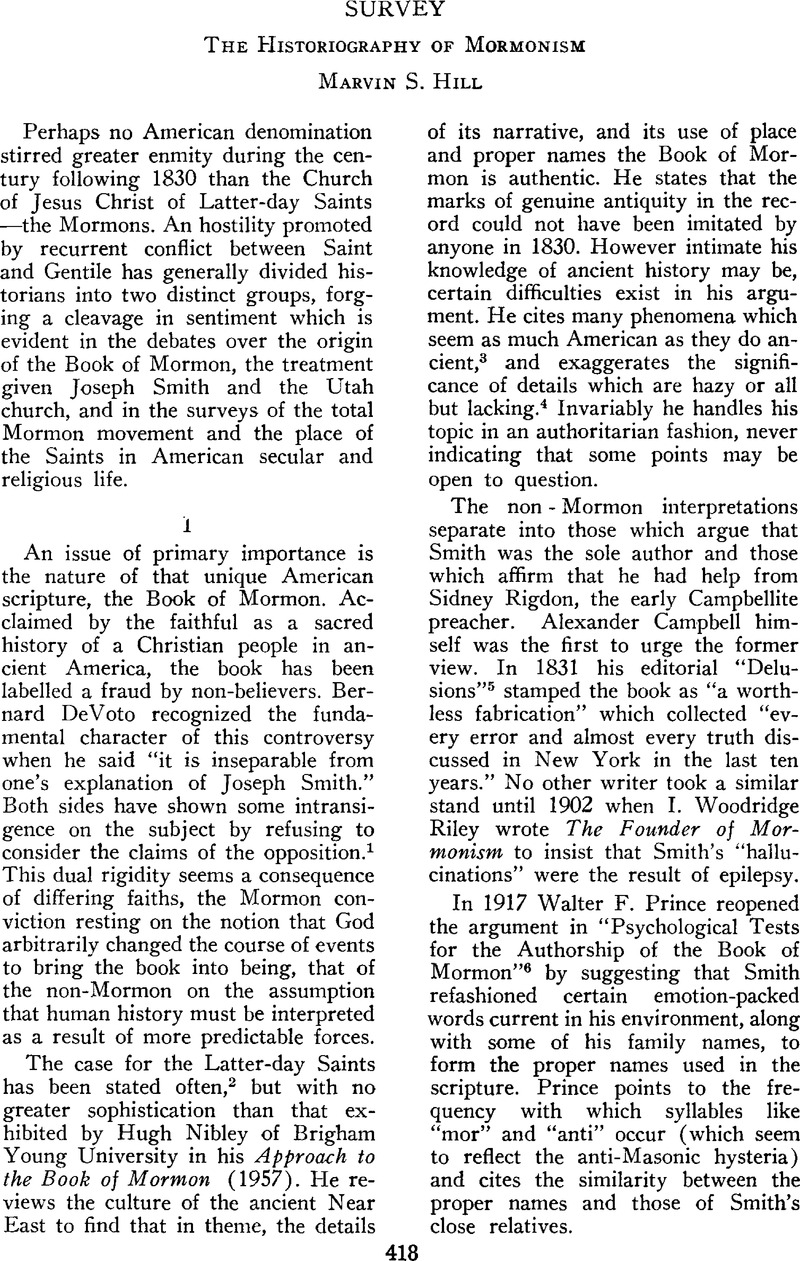Article contents
The Historiography of Mormonism
Published online by Cambridge University Press: 28 July 2009
Abstract

- Type
- Survey
- Information
- Copyright
- Copyright © American Society of Church History 1959
References
1. See DeVoto, Bernard, Forays and Rebuttals (Boston: Little, Brown and Company, 1936), p. 91Google Scholar, and Nibley, Hugh, An Approach to the Book of Mormon (Salt Lake: Deseret News Press, 1957), p. 25.Google Scholar
2. I counted forty-five books and articles written between 1940 and 1953 to defend the Book of Mormon.
3. Nibley, pp. 140, 202–16, 339, 348.
4. He concludes that Lehi was a merchant and bases much of the first part of his argument on this assumption. But there is little concrete evidence to support it. See pp. 38–39 and compare the appropriate citations. He matches the society described in Alma 23 with Qumran (p. 157), but the Book of Mormon lacks sufficient detail for such a comparison.
5. “Delusions,” The Millennial Harbinger, II (1831), p. 93.Google Scholar
6. Prince, Walter Franklin, “Psychological Tests for the Authorship of the Book of Mormon,” The American Journal of Psychology, XXVIII (07, 1917), 373–89.CrossRefGoogle Scholar
7. Theodore Schroeder, “Authorship of the Book of Mormon,” Ibid, XXX (January, 1919), 66–72.
8. Prince, p. 379.
9. Ibid., pp. 380–88. The given names which I have used are those of my immediate family.
10. Smith, Ethan, View of the Hebrews: or the Ten Tribes of Israel in America (Poultney, Vermont, 1825)Google Scholar. In an examination of his second chapter I found that he quotes Isaiah ten times, Ezekiel six, Hosea four, and several other books once or twice. The Book of Mormon (1920 edition) cites Genesis, Jeremiah and Malachi as well as Isaiah. See pp. 10, 36, 446.
11. Compare Ethan Smith's opening chapter with the Book of Mormon, pp. 1–3.
12. Chase, Daryl, “Sidney Rigdon, Early Mormon” (Unpublished Master's thesis, University of Chicago, 1932), pp. 57–59.Google Scholar
13. Cannon, George Q., “The Life of Joseph Smith, The Prophet (Salt Lake: The Juvenile Instructor Office, 1888), p. xxiii.Google Scholar
14. See his fantastic account of one-hundred-fifty Missourians being “put to flight” by twelve Mormons, Ibid., p. 249.
15. He uses Joseph's “first vision” to define the early Saint beliefs. Brodie has questioned the authenticity of this manifestation. See Brodie, Fawn, No Man Knows My History (New York: Alfred A. Knopf, 1946), pp. 21–25.Google Scholar
16. Admittedly Brodie has corroborated these stories where possible but see pp. 125–26, 147, 183, 196–97, 222.
17. Ibid., see pp. 36–37, 72, 80, 297.
18. Ibid., pp. 434–65.
19. Caswall, Henry, The Prophet of the Nineteenth Century (London, 1843), pp. 209–10.Google Scholar
20. Arbaugh, George Bartholomew, Revelation in Mormonism (Chicago: University of Chicago Press, 1932), p. v.Google Scholar
21. Ibid., pp. 69–95.
22. Ibid., pp. 77–78. Contrast this with West's discussion of the Zion's Camp affair. West, Ray Benedict, Kingdom of the Saints (New York: The Viking Press, 1957), pp. 54–56.Google Scholar
23. Ibid., pp. 88, 90–93.
24. Hunter, Milton R., Brigham Young the Colonizer (Salt Lake: Deseret News Press, 1940)Google Scholar. His chapter on the Mormon corridor was first published in the Pacific Historical Review, VIII (June, 1939), 179–200.Google Scholar
25. Young, Kimball, Isn't One Wife Enough? (New York: Henry Holt and Company, 1954). Contrast pp. 82, 102, 309–10 with 110 and 331Google Scholar. Professor Young does not mention Brigham in his discussion of the “Reformation” and Mountain Meadows.
26. Ely, Richard T., “Economic Aspects of Mormonism,” Harpers Monthly Magazine, CVI (04, 1903), 667–78.Google Scholar
27. Ibid., pp. 669–76. Lowry Nelson, Joseph Geddes, Edward Allen and Gardner have published developments of the prominent themes in Ely's piece.
28. Gardner, Hamilton, “Cooperation Among the Mormons,” The Quarterly Journal of Economics XXXI (05, 1917) 461–99CrossRefGoogle Scholar and “Communism Among the Mormons,” Ibid., XXXVII (November, 1922), 134–74.
29. See “Normonism's ‘Gathering’: An American Doctrine with a Difference,” Church History, XXIII (September, 1954), 248–64Google Scholar: “Immigration and the ‘Mormon Question’: An International Episode,” The Western Political Quarterly, IX (June, 1956), 416–33Google Scholar; and “Image of Zion: Mormonism As An American Influence in Scandinavia,” Mississippi Valley Historical Review, XLIII (June, 1956), 18–38.Google Scholar
30. DeVoto, Bernard, “The Centennial of Mormonism,” The American Mercury, XIX (01, 1930), 1–13.Google Scholar
- 3
- Cited by


